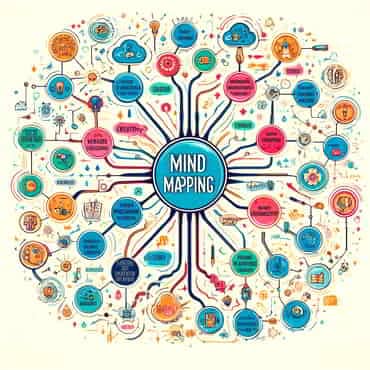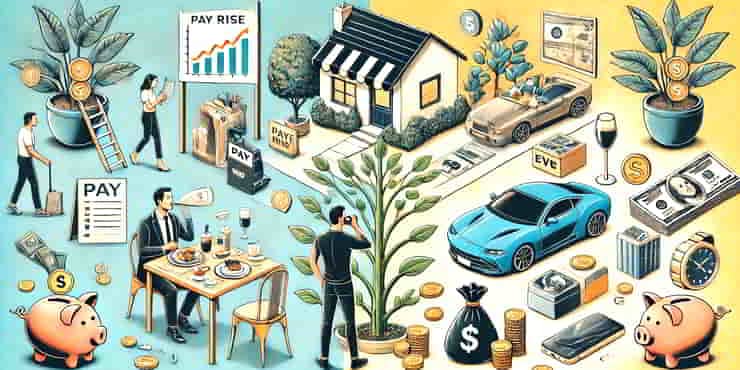Mind Mapping: Visual Strategies for Enhancing Mental Clarity

Estimated reading time: 6 Min
What exactly is mind mapping, and why has it become the silent ally of thinkers, planners, and creators worldwide?
Have you ever felt like your mind is a browser with too many tabs open?
Each tab is a thought, a task, or a reminder, and just when you think you’ve closed one, another pops up.
This is where the magic of mind mapping can help.
Mind mapping is a tool for organising your thoughts; it works like a mirror, reflecting the intricate web of your thoughts and transforming them into a visual blueprint.
Here, we untangle the threads of confusion and weave them into a clear, cohesive tapestry.
The Science Behind Mind Mapping
Mind mapping is more than just drawing; it’s an echo of our thinking.
It mirrors the way our brain weaves information into a structured format.
Picture this: in the centre of a blank canvas lies your central idea.
Like a tree, it branches out into subtopics, details, and even finer threads, forming a network of interconnected ideas.
This structure may start in a random way.
But as it gets organised, it reflects the brain’s penchant for associating new information with existing knowledge, enhancing both recall and creativity.
The genius of mind mapping lies in its simplicity and its alignment with our brain’s natural inclination for visual processing.
Studies have shown that integrating visual elements like colours and images with text can significantly improve memory and understanding.
The reason?
For most of us, our brains process visuals faster than text, and by mapping out information visually, we’re playing to our strengths, fostering a deeper and more intuitive grasp of the ideas.
The Basics of Mind Mapping
Creating a mind map is like painting, but instead of paint, we use ideas.
It starts with a single concept at the centre of your map.
From there, branch out with key themes or subtopics related to your central idea, creating a visual hierarchy.
Each branch, in turn, can sprout leaves—smaller, related ideas or facts.
The beauty lies in its flexibility; there’s no right or wrong way to create a mind map, only your way.
However, while creativity reigns supreme, a few guidelines can help.
First, keep it clear and simple: use single words or short phrases.
Next, use colours and symbols to differentiate and highlight ideas.
This isn’t just for aesthetics; it enhances memory and helps categorise concepts.

Finally, embrace your personal style.
Your mind map should be a reflection of your thought process.
Yet, as we chart these mental explorations, beware of common pitfalls.
Overcrowding your map or drowning it in text can lead back to confusion, the very beast we’re trying to tame.
Remember, unlike the image, the goal is clarity, not chaos.
Mind Mapping for Various Aspects of Life
Imagine if there was a Swiss Army knife for the brain.
Well, mind mapping comes close.
In the bustling world of business and project management, mind maps can declutter minds and agendas.
They streamline tasks, set clear objectives, and foster teamwork by providing a clear, shared vision.
But the magic doesn’t stop at the office door.
In the realm of personal development, mind maps can be powerful allies.
They help in setting tangible goals, resolving personal conflicts, or planning life changes.
They provide a canvas to paint our aspirations vividly, making them more attainable.
Educationally, mind maps transform monotonous notes into vibrant landscapes of knowledge.
They make learning an adventure, not a chore, appealing to visual learners and note-takers alike.
And for the creatives?
Mind maps are the brainstorming partner you’ve always dreamed of—sparking ideas, connecting seemingly unrelated concepts, and turning creative chaos into a structured masterpiece.
Mind Mapping Tools and Resources
Gone are the days when mind maps were confined to scraps of paper.
In our digital age, a plethora of tools and resources await.
From simple, user-friendly apps to sophisticated software, there’s something for every need and skill level.
But how do you choose?
Consider your goals:
Are you mapping complex data or simple concepts?
Do you prefer the tactile feel of pen and paper or the versatility of digital platforms?
While traditionalists might stick to paper, the digital domain offers enticing benefits: easy edits, boundless space, and the ability to share and collaborate online.
Tools like MindMeister, XMind, or Bubbl.us cater to various needs and preferences, offering features like cloud storage, team collaboration, and integration with other platforms.
Yet, the abundance of options can be overwhelming.
Start with free versions or trials, test different platforms, and find the one that works best with your way of thinking (I use Xmind).
After all, the best tool is the one that feels like an extension of your mind.
Advanced Mind Mapping Techniques
Now, let’s elevate our mind mapping from science to art.
Imagine incorporating colours, not just as a decorative tool but quickly becoming a language speaking directly to your memory and emotions.
Perhaps blue is for calm insights, red is for urgent tasks, and green is for growth and ideas.
It’s no longer just a map; it’s a canvas, where each hue has a purpose, guiding your mind through the landscape of your thoughts.
But why stop at colours?
Integrate images, symbols, or even emojis to replace or accompany words.
Visual cues can act as powerful memory triggers, making your map not only more engaging but also easier to recall.
This technique is especially useful for complex or abstract concepts, breaking them down into understandable and memorable pieces.
And as your skills grow, so can your mind maps.
Start intertwining them with other productivity tools and methods.
Merge them with your to-do lists, project plans, or learning materials.
Use them to dissect problems, breaking them down layer by layer, or to map out the potential outcomes of decisions.
The possibilities are as vast as your imagination.
Real-life Examples and Case Studies
Consider John, a project manager who felt overwhelmed by the scope of his projects.
By adopting mind mapping, he was able to break down complex tasks into manageable pieces, assign roles clearly, and track progress effectively.
Or take Sarah, a student who struggled with traditional note-taking.
Mind mapping helped her visualise the connections between different concepts, leading to a deeper understanding and improved memory recall.
These stories are not unique.
They echo the experiences of countless individuals and organisations worldwide who have harnessed the power of mind mapping to clarify thoughts, streamline workflows, and enhance creativity.
Their successes underline a universal truth: regardless of your profession or life stage, mind mapping can unlock a new dimension of clarity and efficiency.
Overcoming Challenges and Misconceptions
Embarking on your mind-mapping journey can seem daunting.
Common barriers include a reluctance to try new methods, a belief that one’s thoughts are too disorganised to map, or misconceptions that mind mapping is only for visual thinkers.
But these challenges are surmountable.
Start small, be patient with yourself, and remember that every expert was once a beginner.
Moreover, dispel the myth that mind mapping is a one-size-fits-all solution.
It’s a flexible tool that can be adapted to fit individual needs and styles.
Embrace the uniqueness of your thought process, and allow your mind map to be a reflection of that.
Summary
Mind mapping is more than a method; it’s a journey towards mental clarity and improved productivity.
It’s about transforming the tangled webs of our thoughts into a structured, visually engaging format that not only aids in understanding and recall but also sparks creativity.
As we conclude, I encourage you to take that first step.
Pick up a pen or open a digital tool, and start mapping.
Remember, the aim is not perfection but progress.
With each map, you’ll navigate closer to the clarity you seek, turning the chaos of information overload into islands of insight and understanding.
😉
Richard
Additional Resources:
For those eager to dive deeper, there are numerous books, websites, and online courses dedicated to mind mapping.
Especially, explore works by Tony Buzan, the pioneer of modern mind mapping, or delve into online communities where enthusiasts share tips and maps.
Resources like MindMapping.com or the Biggerplate community can offer guidance, inspiration, and support as you explore the vast landscape of visual thinking.
Remember, the journey of a thousand miles begins with a single step—or, in this case, a single branch.
Happy mapping!






